Multi-Domain Battle: A Perspective on the Salient Features of an Emerging Operational Doctrine
Amos C. Fox
The 19th century Prussian general and military theorist Carl von Clausewitz defined war in three ways. He postulated that war is a duel, an act of force to compel one’s enemy to do its will, and a collision of living forces. Further, Clausewitz stated that the use of force is the means of war, and that the true aim of war is to render the enemy powerless[1], “That the grand objective of all military action is to overthrow the enemy – which means destroying his armed forces.”[2]
Clausewitz’s definition of force was focused solely on physical force, but as time and technology progressed, “force” has shifted from physical force applied from land and naval forces, to more intangible forms of force. At the national level “force” can be understood as the elements of power - diplomacy, information, military, and economic. At the strategic, operational, and tactical levels, “force” operates on land, in the air, in the sea, and through informational, cyber, and electronic means. All of which suggests that the use of force in the pursuit of national objectives, or war, is now a multi-domain endeavor.
Current proponents suggest that multi-domain battle will occur against peer competitors in contested environments, providing the US Army and its joint partners with a much thinner margin of victory than in the recent past. As such, US forces should look to create zones of proximal dominance to enable the active pursuit of objectives and end states, and that dislocation is the key to defeating an adversary capable of multi-domain operations. This essay will briefly describe multi-domain battle, then analyze the role that dominance, dislocation, and operational frameworks, play in relation to victory in multi-domain battle.
Defining Multi-Domain Battle
Multi-domain battle represents another evolution in the conduct of warfare. Therefore, one must cast fresh eyes upon the problem of how to fight and win in a multi-domain environment. 20th century British military theorist, J. F. C. Fuller, provides excellent ideas on evolutions in warfare. In his pivotal work, The Foundations of the Science of War, Fuller stated,
If mentally we cannot keep pace with the changes in the physical elements of war – the changes in weapons, movement, and protection – then our strategy and our tactics will remain obsolete: that is to say, they will not enable us to express the principles of war when once again we are called upon to apply them.[3]
To keep pace with the evolutions of warfare, one must clearly understand the character of the environment in which they find themselves. Similar to the advent of AirLand Battle to address Soviet armies trundling into Central Europe, multi-domain battle (MDB) doctrine is being developed to address the interconnected, omnidomain battlespace of the 21st Century. Though not formally captured in US Army doctrine, multi-domain battle is an operational theory of warfare. The MDB theory acknowledges that contemporary warfare is a struggle between opposed systems, in which each participants’ system is open, dynamic, and adaptive. To be sure, TRADOC commander, General David Perkins, stated as much in writing that multi-domain battle, “Advances the proven idea of combined arms into the 21st Century operational environment by describing how future ground combat forces working as part of joint, interorganizational and multinational teams will provide commanders the multiple options across all domains that are required to deter and defeat highly capable peer enemies.”[4] Additionally, General Perkins posits that MDB will require US ground forces to fight for contested terrain against ensconced enemies who are seeking to retain a position of relative dominance.[5]
For its part, US Army doctrine is less descriptive than General Perkins. Army Doctrinal Reference Publication (ADRP) 3-0, describes the concept in stating that, “Army forces conduct multi-domain battle, as part of a joint force, to seize, retain, and exploit control over enemy forces.”[6] To accomplish this, Army forces must deter threats, deny an opponent’s ability to freely operate on the battlefield all the while maintaining freedom of movement and maneuver, in all domains.[7] In essence, the Army’s operations manual casts a wide net around the concept, while providing insufficient information to make it tangible. One can expect refined information as the construct is finalized and officially incorporated into doctrine.
The blogosphere is replete with discussions on multi-domain battle—so many in fact, that it makes honing in on one perspective very difficult. However, one of the leaders in this discussion is War on the Rocks (WoTR). A recent essay at WoTR stated that multi-domain battle is focused on viewing the theater as a “unitary whole,” and that, “Maximizing domination of the domains will be a precondition for further actions. Increasingly, the joint force will be able to look to land-based, long range fires and effects whose locations are hidden from an enemy’s view and reach.”[8] The idea of dominance, whether explicitly stated as in the War on the Rocks essays, or indirectly stated, is fundamental to understanding action in multi-domain battle.
Synthesizing the previous descriptions of MDB yields two major trends. The first is that MDB is built on the assumption that the United States will not be the sole proprietor of battlespace dominance in future conflict. And second, MDB will pit the United States against peer competitors. Those peer competitors will have layers to their force, much like the layers of an onion obfuscate each subsequent layer. Hence, capabilities will have to be debrided in order to defeat the heart of the peer competitors fighting force. Developing plans to fight and win in contested battlespace, against peer competitors with layered capabilities, demands an understanding of the role dominance.
The Character of Dominance in Warfare
It is instructive to understand the character of dominance, because in doing so, leaders will be better positioned to manipulate force and resources in the pursuit thereof. In musing on dominance, one must start with first-order questions: 1) what is the character of dominance, 2) how is it measured, and 3) what are its modulating features? Understanding the answers to those questions will allow leaders to develop stratagems to positively manipulate dominance. Furthermore, while the answers to those questions are important, the process of examining those questions is of equal importance because doing so breeds familiarity with dominance’s components and interdependencies. The benefit of which is a contextual understanding between the relationship of components, which enables leaders to plan for, or plan against, when seeking to positively manipulate the cross-domain battlespace.
First, dominance is provisional – it is fleeting, fragile, and prone to shock or surprise. The primary conditions that govern the provisional character of dominance are resource requirements and time. Furthermore, dominance requires resource stabilization and resource overmatch in relation to the enemy, duration of the mission, and self-sustainment considerations. Therefore, there is a proportional relationship between resource expenditure and the ability to gain or preserve dominance - the great the expenditure in resources, the less likely one can gain or maintain dominance; or as Clausewitz stated, “The higher the ends, the greater the number of means by which they may be reached.”[9]
Dominance, being resource dependent, is measurable. Zones, degrees, and duration are the metrics in which dominance can be measured. These categories can serve as tools for assessing both friendly and enemy dominance. What is more, those metrics can be used in forecasting when, where, and for how long a force may, or may not, possess dominance.
Because of the interdependency with resources, anything an adversary can do to negatively impact its opponents’ resources will influence its ability to maintain dominance at a specific point in time and space. These actions include not only action directed at resources, but actions that force an adversary to expend resources at locations, times, or for durations for which it was not prepared, or that exceed pre-planned allocations (See Figure 1). Specific examples may include preemptive attacks, spoiling attacks, attacks on a shaping effort, or long, attritive actions intentional conducted to deplete an enemy’s stocks.
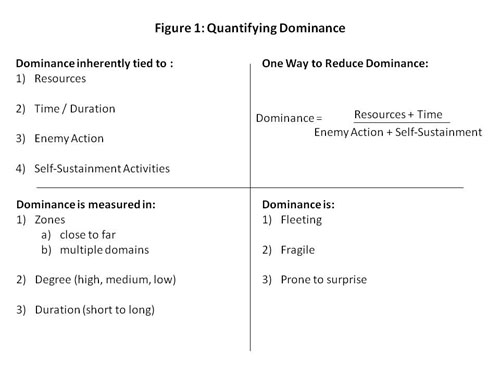
Applied Dominance: Zones of Proximal Dominance
Forecasters predict that future wars will likely necessitate US forces having to establish lodgments and conduct offensive action in heavily contested environments in which peer competitors levy cross-domain capabilities to thwart US action. The take-away being that US forces will likely have to fight for every yard of territory in pursuit of their objective. Conversely, adversaries will seek to retain control of the battlespace. This contest of wills for local control is not an end unto itself, but a mean in which to enable continued freedom of movement, which in turn, enables continued pursuit of objectives or end states. General Perkins’ echoed this position in writing that US ground forces conduct action to, “Capitalize on the temporary windows of localized control to seize, retain, and exploit the initiative.”[10]
However, one must remember that localized control is not the goal, but a tool in achieving a goal. Therefore, an evolved way of thinking about localized control should be considered. On way to envision applied localized control is to think instead in terms of zones of proximal dominance.
Zones of proximal dominance should be thought of as an orb of power which radiates from a central position (See Figure 2). Power radiation is proportional to the strength of the formation, and the strength of the adversary in the operating environment. Power radiation is omnidirectional or unidirectional, depending on the character in which the formation is engaged; however, it is likely that in most cases power radiates directionally—towards an adversarial force (See Figure 3).
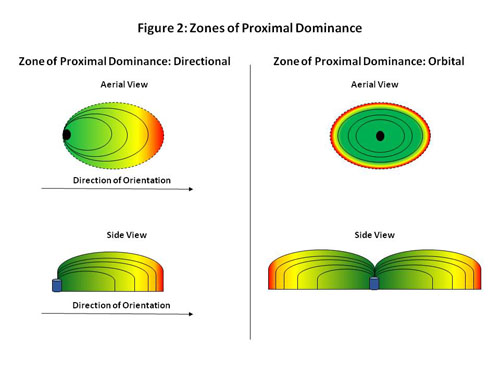
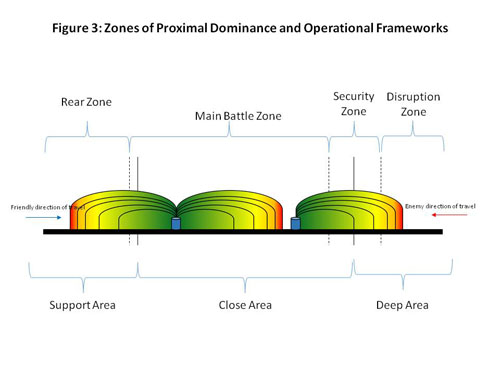
Like dominance, zones of proximal dominance are fleeting, fragile, and prone to surprise or shock. They are also inherently tied to force capabilities and resource stabilization. Moreover, zones of proximal dominance are as mobile as the force in which they exist. Finally, they too can be measured in degrees and duration. Leaders can group zones of proximal dominance to achieve greater zones of dominance, providing leaders the freedom of movement required to maintain tempo in pursuit of objectives and end states (See Figure 4).
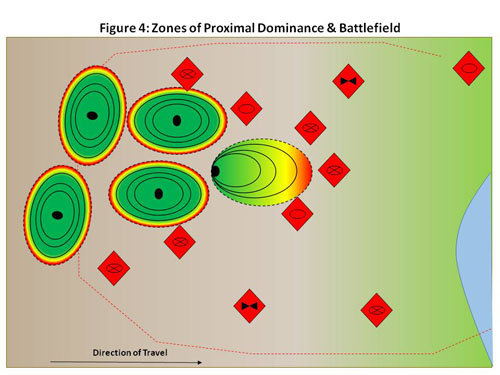
Understanding zones of proximal dominance, in conjunction with the character of dominance, enables leaders to positively influence the battlespace for US forces. Positively influencing dominance enables leaders to project power, attain positions of relative advance, maintain freedom of maneuver, and exploit opportunities when they present themselves. Conversely, understanding the character of dominance allows leaders to develop stratagems to negatively influence an enemy’s grip on dominance. Leaders that understand the relationship between resources, time, and self-sustainment are better able to attack those capabilities and joints in relation to an adversary in order to tip the balance of power, or dominance, towards friendly forces.
The Relationship and Tension Between Force Capabilities
Force capabilities (i.e. direct fire weapons, indirect fire weapons, cyber, electronic, information, reconnaissance, et cetera) are the means used to influence dominance. These tools of applied force are not employed in a wanton manner throughout a battlespace. When used correctly, they represent parts of a whole, in which the actions of one support the utility of the others. This is not unique to multi-domain battle, but has existed since the advent of combined arms warfare. Combined arms warfare has always sought to integrate multiple arms to be used in a complimentary manner, to not only achieve synergistic effects, but to unlock the potential power of each individual arms.
Specifically, when opponents meet on the battlefield a disparity often exists between the range of their weapon systems, whether this be kinetic firepower or intangible ‘firepower’ such as cyber, electronic, or information capabilities. The weapon that can range the furthest is a ‘protective weapon,’ while the weapon of shorter range is the true fighting instrument.[11] One can see this concept in the use of long-range fires, cyber, and electronic attack to set the conditions for a combined arms assault of a given objective.
The Russo-Ukrainian War’s Second Battle of Donetsk Airport provides a contemporary example of this idea. The battle, fought from September 2014 to January 2015, outside the city of Donetsk, Ukraine, pitted Russian and separatist forces against Ukrainian army and volunteer battalions. Russian forces used long-range fires during the battle to swarm the Ukrainian forces isolated at the airport. When a given set of conditions were met, Russian tanks and infantry assaulted the remaining Ukrainian forces, sealing the battle as a Russian victory.[12] Russia used its long-range fires much like a shield, to allow it to get into position for the killing blow with its tanks and infantry.
In analyzing the previous point from another perspective, one can further deduce that the true fighting power of a formation is not in the items on the periphery, but in its inner core. A RAND study suggests that, “Close-in capabilities may prove to be as, if not more, important than the ability to strike targets from a distance.”[13] The outer layers of a formation serve two purposes – to protect the inner core, and to shape the enemy to set the conditions for the inner cores success.
Taking this concept to its conclusion, one must understand that in multi-domain battle they must first strip away, or dislocate, the protective layers of an enemy’s force in order to destroy the its strength, or its inner core.[14] In the cross-domain environment, an enemy’s outer core is its cross-domain and joint capabilities. Therefore, the more of the enemy’s outer can be cleaved away or neutralized, the more success friendly forces will have in defeating the enemy’s main fighting force. Dislocating the outer layers and destroying the inner core will, in essence, defeats the cross-domain enemy.
Dislocation – A Foundation for Victory in Multi-Domain Environments
As mentioned previously, a primary objective in multi-domain battle is to neutralize the enemy’s ‘protective’ layers to enable forces to close with and destroy the enemy’s inner core, or to put it more plainly, to shape the enemy for contact with US ground forces. On the multi-domain battlefield, in which enemy formations have access to a panoply of interconnected enablers, denying them access to those tools is paramount. Dislocation is a critical component of defeating an enemy with cross-domain capabilities because it denies the enemy access to its tools, renders those tools irrelevant, or forces the enemy into environments in which those tools are ill-disposed.
Writing on dislocation, Liddell Hart stated that, “In most campaigns the dislocation of the enemy’s psychological and physical balance has been the vital prelude to a successful attempt at his overthrow.”[15] Army doctrine, recently incorporating the concept, states that dislocation is the use of forces to gain a position of advantage in relation to the enemy, nullifying its force’s value.[16] However, a far more developed concept on dislocation exists. American military theorist Robert Leonhard defined dislocation as, “The art of rendering the enemy’s strength irrelevant.”[17] Nevertheless, Leonhard’s use of the term truly bears fruit in conveying the process associated with the art.
Leonhard contends that dislocation is at heart of achieving advantages in combat. The motivating thought is that in dislocating an enemy, a friendly force will be able to avoid the enemy’s strength, creating a position of relative advantage in which defeat of the enemy will come at a far cheaper expense. In pursuit of this idea, one must understand that an adversary’s force possesses both strengths and weakness.[18] As such, an adversary’s strength contains two elements – a component and a condition.[19] In the open, adaptive systems that dominate the multi-domain battlefield of today, one could view the components of an enemy’s strength as its capabilities—cross-domain, combined arms, and individual arms.[20] Together, they achieve synergistic effects that compensate for the weakness of the other capabilities; but individually, or in the wrong environment, the components lose much of their power and utility. Moreover, if one understands the conditional nature of an enemy’s strength, they will in turn understand that the two methods to defeat it are through the destruction of those components and through altering the conditions in which the components derives their strength.[21] Understanding how enemy capabilities lose power, or the conditional nature of strength, is critical to effective operational art and planning.[22]
Therefore, US forces, operating in a multi-domain environment, must dislocate adversaries to attain victory. To do so, US forces must debride the adversary of its cross-domain and combined arms capabilities, or its outer layers of force. Doing so yields two results. First, it exposes the adversary’s inner core, which in most cases, is where the heart of the enemy’s warfighting strength resides, which is why it is protected in the first place. Second, it allows US forces to create zones of proximal dominance, which when grouped, become larger zones of dominance. Grouped zones of proximal dominance provide US forces with the freedom of maneuver required to close with and destroy the heart of the enemy’s fighting force.
Thinking clearly about dominance, dislocation, and multi-domain battle also dictates that Army leaders understand they are not operating in a vacuum. Mindful enemy’s will likely seek to positively affect dominance and seek to dislocate US forces, whether that be physically, functionally, temporally, or politically. US forces, whose proclivity for ‘seizing the initiative’, must ensure that that attitude is not a tool used for manipulation by cognitive peer competitors or other situationally aware adversaries. Competent enemies are likely to use dispositions for assertiveness as a counterweight against those seeking to employ initiative. Put to it plainly, one must be aware than seizing the initiative can often be used to lure a force into a trap - the Russo-Ukrainian War’s Battle of Debal’tseve provides an excellent example of this potential conundrum.
Prior to the battle Ukrainian forces possessed Debal’tseve, which represented a salient into the Russian/separatist controlled Donbas region of Ukraine (Figure 5 and 6). Russian forces made gestures towards Debal’tseve, indicating intentions on the city. As a result of this stimulus, Ukraine attempted to seize the initiative, and rushed forces into the city. Russian forces, employed a melding of swarm and siege warfare, encircled the city and slowly battered the isolated forces for over a month. The result was that Russian forces took the city, which they largely flattened with rocket and artillery fire. Ukrainian forces in the battle were destroyed – reports indicate the two major Ukrainian formations, the 128th Mechanized Brigade and the volunteer Vostok Battalion, were all but annihilated. The Ukrainian forces suffered 300 dead, 700 wounded, and 100 captured.[23] Furthermore, the civilian population was ravaged – of 25,000 inhabitants, 6,000 were killed and 8,000 more fled the city.[24] The Russians, aware that Ukraine would quickly allocate forces to the city based upon their previous actions at Ilovaisk, Donetsk Airport, Luhansk Airport, used Ukrainian initiative to benefit the pursuit Russian objectives. The Battle of Debal’tseve clearly illustrates how an adroit adversary can manipulate a force looking to seize the initiative.
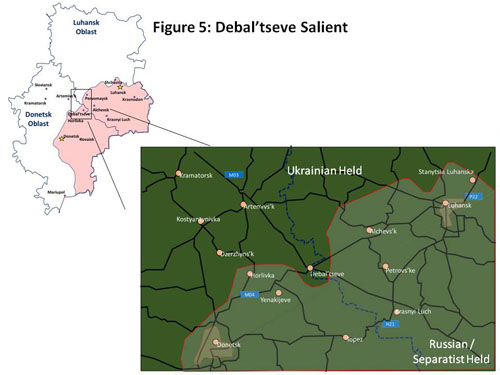
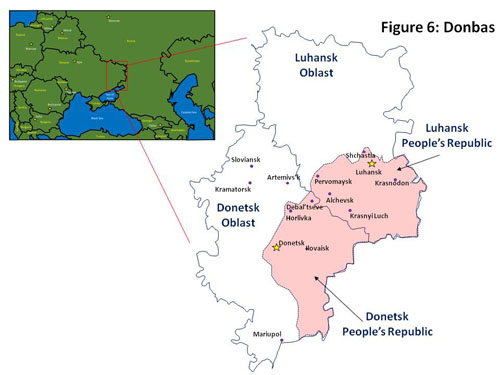
Operational Framework – Getting it Right for Multi-Domain Battle
The next logical step is to examine the Army’s operational frameworks in relation to MDB. ADRP 3-0 describes operational framework as a hierarchy, with the area of operations being at the top of the hierarchy, followed by the deep-close-security area construct to define forces in time and space, then the decisive-shaping-sustaining to identify priority by purpose, and finally, the main effort-supporting effort construct to identify priority by resource.[25]
However, the evolving character of the multi-domain battlespace suggests that the deep-close-support area construct is insufficient. ADRP 3-0 defines the deep area as, “The portion of the commander’s area of operations that is not assigned to subordinate units.”[26] ADRP 3-0 continues, stating that the deep area extends beyond subordinate unit boundaries to the farthest reaches of a unit’s area of operations and that commanders and that commanders conduct operations within the deep area to influence future events in time, space, and purpose.[27] This view of the deep area is passive, reactive, and cedes initiative to aggressive opponents. On the multi-domain battlefield, in which adversaries will use a variety of tools to assist them in weakening US forces before making contact with the main body, dominating the space between the main body and the enemy force is critical. Therefore, a more descriptive operational framework is required.
The Army’s Opposing Force Tactics manual provides a good starting point by describing the operating environment, whether linear or non-linear, into zones. The zones are defined by purpose within each zone.[28] The benefit of this concept is that it enhances planning by providing structure to the battlefield, better allowing leaders to arrange formations in time, space, and purpose. Additionally, the proposed construct is assertive and provides inherent guidance, whereas the deep-close-support framework does not. A commander instructing his staff, “We’ve got to win the disruption zone fight” makes more tangible sense to a staff or subordinate commanders than does a nebulous statement such as, “We’ve got to win the deep fight.”
Restructuring the operational framework to align zones by purpose will likely enhance planning and execution in multi-domain environments by allowing leaders to align formations by purpose. The forward edge of this proposed framework should be the disruption zone. The disruption zone is defined as, the geographical area and airspace in which a force will conduct disruptive action forces conduct action within the disruption zone to attack specific components of the opposing force, to break apart their system, in order to create windows of opportunity for the main body force to exploit.[29]
The adaptation of the battlespace into zones, incorporating a handful of the ideas from Opposing Force Tactics, would bring this idea to fruition. TC 7-100.2 describes the battlefield, linear and non-linear, in terms of zones – disruption zone, battle zone, and support zone. The disruption zone is where forces conduct actions to shape the adversary through fixing actions, attritive long-range fires, and actions seeking to break apart the cohesiveness of opposing formations, creating zones of proximal dominance, or windows of opportunity, which can be exploited by main body forces. The battle zone is the sector of the battlefield in which main body forces seek to destroy disorganized enemy formations. The support zone is the sector of the battlefield that is relatively free from enemy forces and houses the logistics and sustainment infrastructure.[30]
However, a more nuanced description of the battlefield’s zones would be beneficial. In addition to the disruption zone, a security zone should be added to provide leaders more depth in which to conduct dislocative action and to counteract enemy cross-domain and swarm capabilities. The security zone would be the buffer area between the disruption zone and engagement by the main body; the security zone would act as a siphon through which the enemy would pass, where reconnaissance formations would conduct reconnaissance and/or security operations to accurately determine the post-disruption zone assessments of an adversary, while simultaneously conducting battle-hand over with main body forces. The goal of which being to oneself, while disorganizing the adversary.
Depending on the character of the situation, the disruption zone and security zone could also be inverted, having the security zone at the far end of a friendly formation, followed by the disruption zone, battle zone, and support zone. Leading with the security zone might be beneficial when the enemy’s location is less certain, perhaps in situations in which a formation is conducting a movement to contact, or operating in areas in which certainty is reduced, or violence of action must be applied more in a more judicious manner.
Under the proposed battlefield framework, main body forces, charged with accomplishing the mission of the higher headquarters, would operate in the main battle zone. The main body’s actions would be no different than those defined for close area operations in ADRP 3-0, or the battle zone in TC 100-2. Similarly, to stay with the use of the term ‘zone,’ ADRP 3-0’s term ‘support area’ would require adjusting to ‘support zone’ but the purpose of the zone would remain the same as is defined in ADRP 3-0. Figure 7 provides an illustration of this framework. The battlefield, broken down into zones, facilitates better developed plans and action through clearly assigning battle space (i.e. battlefield zones) with purpose and a force allocated to accomplish that purpose.
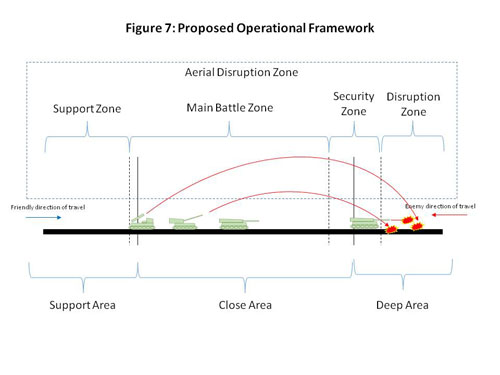
Conclusion
In writing on the importance of understanding the character of warfare in which a force found themselves, Mao Tse-Tung wrote that, “Unless you understand the actual circumstances of war, its nature and its relation to other things, you will not know the laws of war, or know how to direct war, or be able to win.”[31] This essay argues that understanding the character multi-domain battle and its relation to dominance is vital to create favorable conditions. In understanding dominance, leaders will be better suited to develop feasible, acceptable, and suitable operational approaches and tactical plans for the multi-domain environment. Furthermore, this essay argues that leaders should use zones of proximal dominance and dislocative action to achieve victory in multi-domain battle. Dominance is fleeting, fragile, and prone to surprise. Dominance can be overcome through dislocative action to create zones of proximal dominance in contested environments, which provide leaders with the freedom of maneuver required to accomplish their objectives.
End Notes
[1] Carl von Clausewitz, On War, ed. and trans. by Michael Howard and Peter Paret (Princeton: Princeton University Press, 1987), 75.
[2] Ibid., 577.
[3]J. F. C. Fuller, The Foundations of the Science of War (Fort Leavenworth, KS: Command and General Staff College Press, 1993), 259.
[4] General David G. Perkins, “Multi-Domain Battle: Joint Combined Arms Concept for the 21st Century,” Army 66, no. 12 (December 2016): 19.
[5] Ibid., 18-19.
[6] ADRP 3-0, Operations (Washington DC: Government Printing Office, 2016), 3-9.
[7] Ibid.
[8] Albert Palazzo and David P. McLain III, “Multi-Domain Battle: A New Concept for Land Forces,” War on the Rocks, September 15, 2016, http://warontherocks.com/2016/09/multi-domain-battle-a-new-concept-for-land-forces/.
[9] Clausewitz, On War, 159.
[10] Perkins, Multi-Domain Battle, 22.
[11]Fuller, Foundations of the Science of War, 150-151.
[12] Timothy L. Thomas, Russia Military Strategy: Impacting 21st Century Reform and Geopolitics (Fort Leavenworth, KS: Foreign Military Studies Office, 2015), 402.
[13] John Arquilla and David Ronfeldt, Swarming and the Future of Conflict (Santa Monica, CA: RAND Corporation, 2000), 39.
[14] Fuller, Foundations of the Science of War, 150-151.
[15] B. H. Liddell Hart, Strategy (New York: Penguin Books, 1991), 4.
[16] ADRP 3-0, Operations, 2-3.
[17] Robert R. Leonhard, The Art of Maneuver: Maneuver Warfare Theory and AirLand Battle (New York: Ballantine Books, 1991), 66.
[18] Robert R. Leonhard, The Principles of War for the Information Age (New York: Ballantine Books, 1998), 61.
[19] Ibid., 61-62.
[20] Ibid.
[21] Ibid., 61
[22] Ibid., 62
[23] Hugo Spaulding, Ukrainian Situation Report: February 13, 2015 (Institute for the Study of War, Washington, DC), 2015.
[24] United Nations Office for the Coordination of Humanitarian Affairs, “Ukraine: Situation Report No. 29,” February 27th, 2015, accessed on September 29th, 2016.
[25] ADRP 3-0, Operations, 4-4.
[26] Ibid., 4-5.
[27] Ibid.
[28] TC 7-100.2, Opposing Force Tactics (Washington DC, Government Printing Office: 2011), 2-11.
[29] Ibid., 2-14.
[30] Ibid., 2-11-2-15.
[31] Mao Tse-Tung, “Problems of Strategy in China’s Revolutionary War,” Selected Writings of Mao Tse-Tung (Fort Leavenworth, KS: Combat Studies Institute, 2012) 79.
